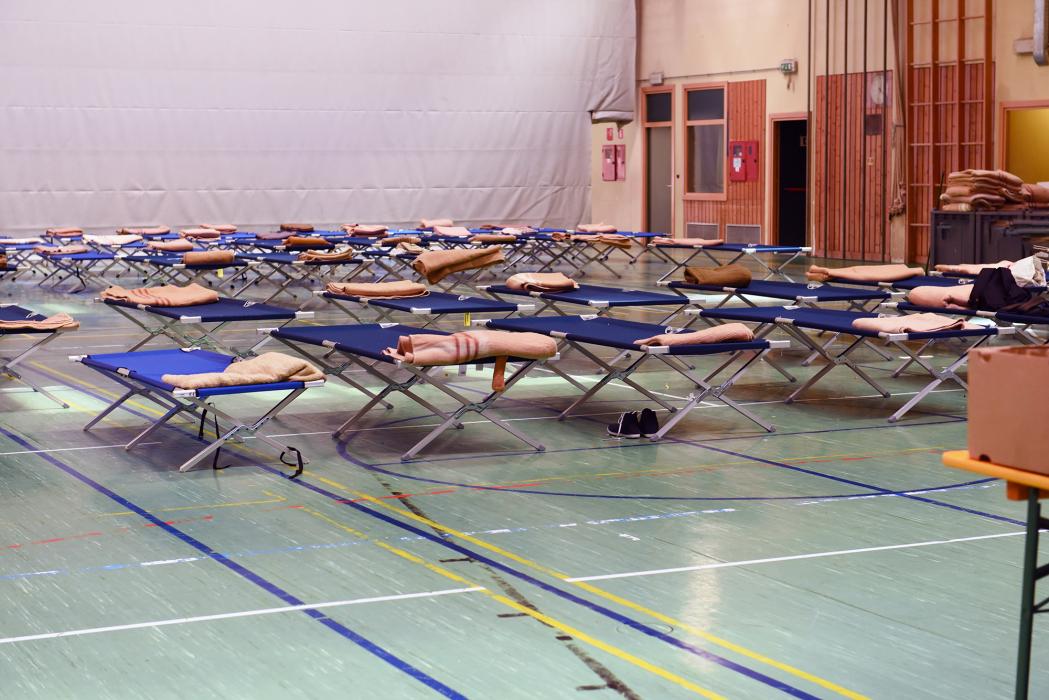The key considerations of converting a building into a temporary hospital

The NHS Nightingale in the UK made global headlines recently – the ExCeL conference centre was converted into what is now the country’s largest hospital in just nine days. The 3500-bed facility is just the first in a planned number of new temporary hospitals to help the country care for people with the virus.
And while – thankfully – demand for hospital beds isn’t as great here in Australia as it is in other parts of the world at present, temporary hospitals have popped up, with a field hospital in Canberra being built in a matter of weeks, and part of Silverwater prison in Sydney being converted to a hospital. Reports suggest the Melbourne Exhibition and Conference Centre is earmarked for conversion should the need arise, too.
Northrop's expert panel of engineers; Todd Bailey (Structural), Peter Young (Mechanical), Craig Hinton (Structural), Mitch Blyth (Civil) and Chris Buntine (Sustainability) discuss the key considerations of converting a building into a temporary hospital.
A senior team ready to go
“In that situation you need your most senior team to be on-site, working through the project as you go within focused working groups,” says Todd Bailey, principal and structural engineer at Northrop.
“In the aftermath of the Christchurch earthquake, this was how we worked. There wasn’t time to sit in the office and plan, you need expert knowledge on the ground.”
Identifying the right building to convert into a hospital
Of course, not any building can be converted into a hospital, so quickly identifying the right site is of paramount importance.
“An ideal candidate building would front a road that has unutilised roadway capacity so that the influx of traffic from the proposed use does not have a significant negative impact on the traffic safety or level of service,” says Mitch Blyth, team lead of civil projects.
Some augmentation of the existing vehicle access points is likely to be required in order to address safety concerns, particularly in terms of sight distances, gap acceptance, visibility and signage.
“Buildings with several different access arrangements would be preferable,” says Mitch, “as this enables separation of staff and visitor traffic, buildings including a capacity for a porte-cochere to act as an ambulance and drop-off offers significant benefits.”
As well as location, building suitability is also a critical consideration.
“Ideally, you’d convert a single storey building,” says Todd. “Multistorey buildings generally won’t have the lift capacity for a stretcher. If you’re trying to upgrade lift car sizes to suit you’re adding significant structural work which would take a lot of time.”
Considering parking and service requirements
Any hospital site also needs plenty of car parking – the volume of parking required for rostered and emergency staff, as well as patient and visitor parking – not to mention service vehicle parking – is likely to be more than a site typically used for commercial purposes.
“If the site has landscaped or open areas that can be converted into temporary car parks it would be an advantage,” says Mitch. “Alternatively, nearby council parks or other open spaces could be converted into car parks.”
Identifying a site with relatively easy access to other services will also speed up the process.
“In terms of location, you ideally need a site that’s close to other services, such as medical imaging and x-rays – putting those types of services in can lead to some major structural work, and consequently timely, costly issues, as floors would probably have to be strengthened,” says Craig Hinton, senior structural engineer.
Undergoing transformation
Site identified, it’s now a case of understanding what work needs to be undertaken to transform it into a hospital, and what services are needed.
“We’d need to identify those high-rated areas, and plan the spaces around those areas, quickly,” says Craig. “Floor height is a big consideration in order to get services in. Asbestos is common in older buildings, so any structural work will need to take that into account.
“Ideally we’d use existing enabled wet areas to avoid cutting into existing floors. Lightweight structural infill would be used if required to minimise and structural strengthening required in the building, while flexible floor plates and temporary partitions would be needed.”
Connecting a temporary hospital
Any building that was converted into a hospital would naturally need services piped in, and Peter Young, principal and mechanical discipline manager, says, “From a services perspective, we’d need to have water and power, and the ability to have temporary services piped in.
“Most commercial offices, for example, would have enough power anyway, but as far as medical gases – oxygen, nitrous oxide etc. – go, you’d use temporary bottles, and you’d design it on that basis. You wouldn’t try to pipe those in permanently.
“You may need to install aircon and put in extra vents and such. So as long as you’ve got the space to do that, and you’d operate them off a central plant, unless it’s an isolation room, in which case you’d have an individual unit.”
Patient and medical worker health critical
When building a hospital in more usual times, sustainability and usability are critical considerations, and shouldn’t be neglected in this case either.
“Locations and aspects that have good daylight and views of nature are well known to accelerate healing and reduce the need for medication for many patients,” says Chris Buntine, Northrop’s sustainability group manager.
“Also of benefit to patients is providing 100% outside air to avoid recirculating disease and installing circadian lighting to promote alertness in some spaces and restfulness in others.”
Healthcare workers are under tremendous pressure anyway, never mind if they were working in a temporary hospital for COVID-19 patients, and their wellbeing must be considered, too.
“The work environment, even a temporary one, must have healthy food options in vending machines or in-house kitchens, and the provision of non-toxic cleaning and sanitising systems such as electrolysed water,” says Chris. “If they have access to adjacent green spaces for mindfulness or exercise breaks, then all the better.”
A collaborative approach
Ultimately, when it comes to converting a building into a hospital during COVID-19, it will require great collaboration between many bodies, including engineers, contractors, local authorities, councils and health authorities to ensure swift action is taken.
Naturally, it’s a very different type of project to work on; timelines are condensed and decisions have to be made in the moment.
Whether it’s a disused hospital that’s being reopened or a commercial building - maybe an office building, factory, pub, club or hotel – that needs converting, a senior team who can be on the ground quickly is required.
And, with the UK setting a nine-day benchmark, some quick decisions will need to be made, too.



